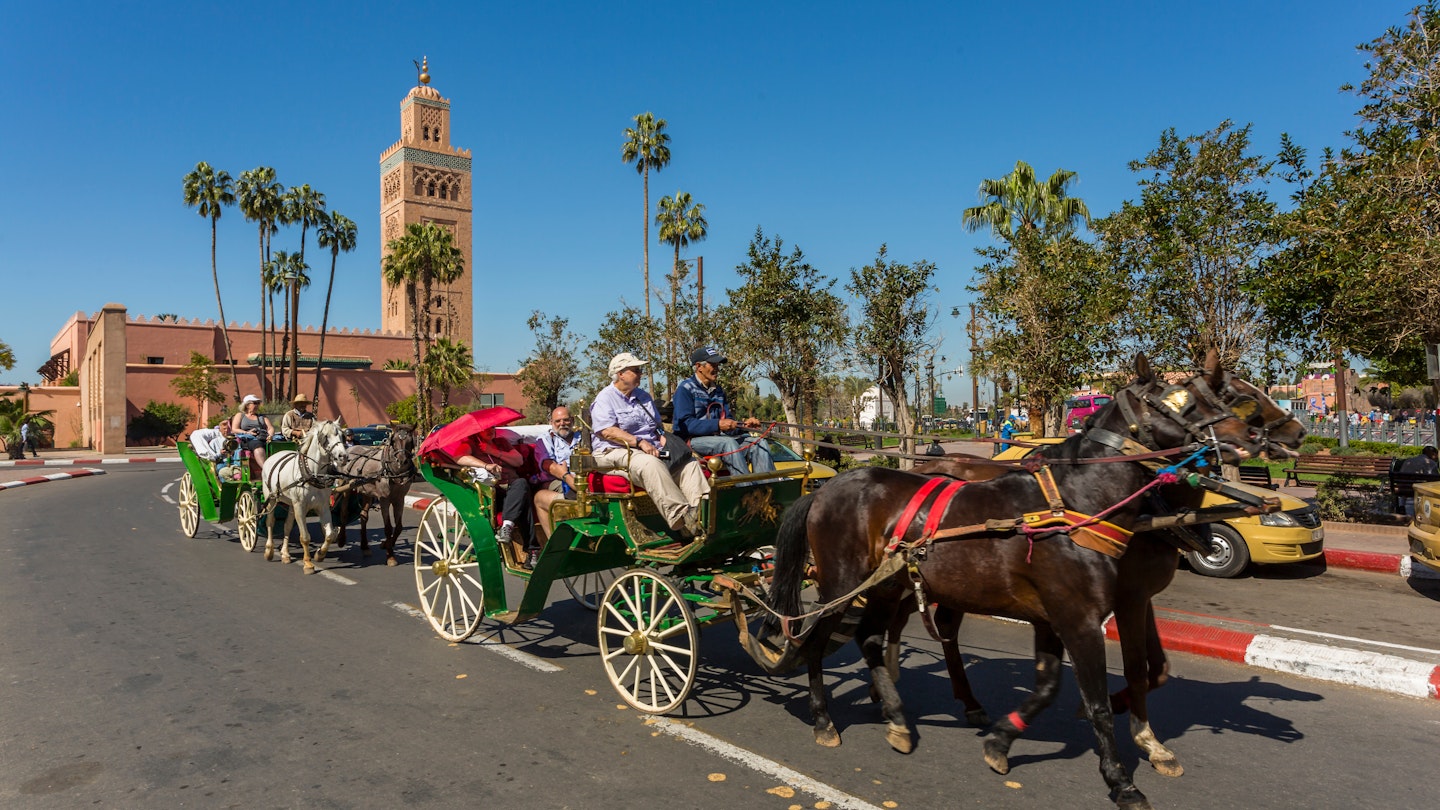Summary

Numerous travelers to Marrakesh invest a significant portion of their time immersing themselves in the ancient medina.
This intricate network of narrow pathways enveloped by terracotta walls, with Africa’s most renowned square – Djemaa El Fna – at its core, was designed for exploration on foot.
To venture beyond the medina, consider engaging in an environmentally sustainable bike excursion, or utilize a readily available yellow petit taxi to access the Ville Nouvelle (new town) and enjoy a leisurely walk through the accessible streets of neighborhoods like Gueliz and Hivernage.
Prepare to wear comfortable footwear and embark on an exploration of the Red City. Here are some strategies for navigating Marrakesh.

Meander around the medina
The medina of Marrakesh is compact and devoid of vehicular traffic, making its array of slender alleys ideal for leisurely wandering. Discover ancient palaces that exhibit Morocco’s most exquisite decorative arts, and indulge in shopping at the souqs (markets) and boutique stores. However, remain vigilant for scooters, carts, and the occasional donkey during your exploration.
Prior to departing, download Maps.Me; however, if you find yourself disoriented—and it is likely—don’t hesitate to seek directions from a shopkeeper. Children may offer to escort you to your destination for a nominal fee.
In the Ville Nouvelle, the Gueliz neighborhood—home to notable attractions such as the Jardin Majorelle and Musée Yves Saint Laurent—features wide avenues and spacious sidewalks adorned with boutiques, art galleries, dining establishments, and cafés. Nonetheless, the absence of shade can render pedestrian excursions uncomfortable, particularly during the summer months.
Join the locals in a taxi
Ride-hailing services, such as Uber and Lyft, are not operational in Marrakesh; however, economical petit taxis can be found throughout the city. Ideally, fares are regulated by the meter, yet be prepared to insist on its use, as many drivers may claim it is “broken” or neglect to activate it altogether, providing inflated rates for tourists. Consequently, be ready to negotiate firmly or exit the vehicle.
It is also common for taxis to pick up additional passengers traveling to the same general location. To avoid any misunderstandings, it is beneficial to write down your destination’s name and address to present to the driver. Furthermore, be advised that they rarely carry change, hence ensure you are equipped with small denominations.
If traveling with a group or heading to more distant locations—petits taxis operate only within city limits—you may utilize a shared grand taxi that follows designated routes. You can reserve all six seats if you prefer a private journey; simply arrive at the taxi terminal and request a “place” to a specified destination.

Tour the city by bike
The flat terrain of this city makes it conducive to cycling; however, it is essential to be a confident cyclist to navigate the challenging traffic conditions. Both Pikala Bikes, a tour operator and community initiative, and AXS provide guided city tours and offer quality bicycles and helmets for rent.
Hop into a horse-drawn carriage
Traditional horse-drawn carriages, known as calèches, present a relaxed means of sight-seeing, particularly when avoiding peak traffic periods around 8 AM and 6:30 PM. These carriages accommodate up to five individuals, with rates approximately 200 MAD ($20) for a 60-minute journey; however, prices may vary to destinations like the Palmeraie—thus, confirm pricing in advance.
The green carriages congregate between Djemaa El Fna and Koutoubia Mosque and around Jardin Majorelle. Ensure to check for a SPANA tag on your horse, as this animal welfare organization microchips the horses to guarantee their well-being and has established water troughs throughout the city.
Buses are the best budget option
Alsa operates city buses; however, they may not be particularly user-friendly for visitors and can often be hot and crowded. Still, bus fares are economical at 4 MAD ($0.40), payable onboard; hence, carrying small coins is advisable.
Line 1 connects the medina to Gueliz, while line 10 services the train station and Bab Doukkla for the bus station. The airport shuttle, at a cost of 30 MAD ($3), operates every 20 minutes between 6 AM and 11:30 PM. Additionally, if you plan to stay in Marrakesh for an extended period, consider the Ikhlas Card from Alsa, which offers a 17% discount on fares.

Driving around Marrakesh isn’t easy
Navigating Marrakesh by car can be daunting. The roads can be hectic with constant traffic and drivers maneuvering between lanes without signaling amid a cacophony of honking horns. Moreover, be prepared to encounter unpredictable pedestrians and groups of scooters, calèches, and donkey carts.
If you are traveling across Morocco, consider collecting your rental vehicle as you depart the city. However, if you need to park in Marrakesh, opt for accommodations that offer private parking, or seek options on the outskirts of the medina or in the Gueliz area near public parking facilities—using Waze can assist in navigation. Depending on location, anticipate paying around 50 MAD ($5) for a full day of parking.
Certain streets in Gueliz feature pay-and-display arrangements, costing approximately 2 MAD ($0.20) per hour, though spaces tend to fill rapidly. If you happen to find street parking without a meter, a parking attendant—referred to as a guardian—will expect around 3–5 MAD ($0.30–0.50) for monitoring your vehicle; ensure to compensate them upon your departure.
There’s not a lot of accessible transportation in Marrakesh
Although Marrakesh offers limited accessible options, it remains navigable for travelers with mobility challenges and a spirit of exploration.
In the medina, wheelchair accessibility may present difficulties, but neighborhoods like the upscale Hivernage and Gueliz are relatively easier to traverse. Public buses and petits taxis typically do not accommodate wheelchairs, although grands taxis do, or one can arrange for a private vehicle and driver through their hotel.
Morocco Accessible Travel specializes in organizing accessible tours within Morocco, including Marrakesh, and provides mobility equipment rentals. The Moroccan guide Houssaine Ichen is also highly regarded. Download GoTravelDaily’s complimentary accessible travel guide for further details.
This article was initially published on April 5, 2021, and subsequently updated on December 3, 2023.





